Hummingbirds are capable of amazing things. They can hover, fly backwards and change direction in mid-air, beating their wings in a figure eight motion anywhere from 50 to 80 beats per second. (The noise of those wingbeats is where the “hum” comes from). Many species migrate over 4,000 miles and can travel up to 1,200 miles non-stop.
On top of all that, these tiny birds have another special superpower: When they show up in your garden, they can stop you in your tracks and mesmerize you with their iridescent beauty and their improbable power.
The Ruby-throated Hummingbird is the only species that regularly breeds east of the Mississippi. 16 others breed in the western U.S., most notably the Rufous, the Anna’s and the Calliope, which at three inches long holds the distinction of being the smallest bird in North America.
There are no differences in foraging habits among species, however. They all feed on nectar, and they get their protein from spiders and small insects.
To attract hummingbirds to your yard, having a variety of flowers waiting for them is ultimately more effective than hanging a feeder. The sugar water in hummingbird feeders will attract bees, ants and other insects, and possibly even racoons and bears if they live in your neighborhood. The feeders also need to be cleaned regularly, not to mention that positioning them near windows increases the risks of injury to the birds from collisions.
So if you want to give hummingbirds what they really want, forget the feeder and grow them some flowers.
But not just any flowers…
The birds have two primary criteria for choosing their favorites: They seek out flowers that have both red hues and a tubular or pendulous shape.
Hummingbirds have highly specialized vision that can see colors outside our spectrum, and the color red looks bolder and brighter to the birds. They’ve learned through evolution that more nectar is waiting for them in red flowers, as bees tend to be more attracted to yellow flowers.
In turn, evolution has made the red flowers appear bolder and brighter to the birds. Plus, the shapes of these flowers have evolved to conform to the specialized beaks of hummingbirds, as the plants rely on them for pollination.
Establishing a perennial garden is the best way to attract hummingbirds. With its lifespan of 3 to 5 years or more and a brain that is proportionately twice as big as a humans’, the bird that finds a good source of flowers in your garden this year will remember exactly where it is and may well return to feed on next year’s blooms. However, if you don’t have the space or the time to devote to a perennial garden, you can still attract hummingbirds with the right annuals, most of which can be grown in containers.
We’ve compiled lists of perennials and annuals that hummingbirds love. Since these birds consume as much as three times their weight every day during their breeding season, hummers can never find enough flowers.
Some of the plants we’ve listed have other attractions besides red, tubular flowers, but all of them will increase your chances of an encounter with one of nature’s most fun to watch little creatures.
Perennial Flowers that Attract Hummingbirds
While any plant can be grown from seed, the better strategy for starting a perennial garden is to start with plants. You can find any of the perennials listed below in a variety of sizes, from mature plants at your local garden center that will produce blooms in their first season to plants in 3-4’’ pots that can be bought from one of several online nurseries.
These “baby perennials” might not mature into blooming plants in their first season, but they will develop strong root systems as they grow. Often, the larger perennials sold in 1-to-3-gallon pots will be rootbound, and even if the roots are loosened before transplanting, they ultimately won’t spread as quickly as the smaller, more nimble plants.
Additionally, some perennials will need to be cut back or divided when they start growing out of their space, while others should be allowed to go to seed completely when they finish blooming, as this is how they reproduce from year-to-year.
Trumpet Vine
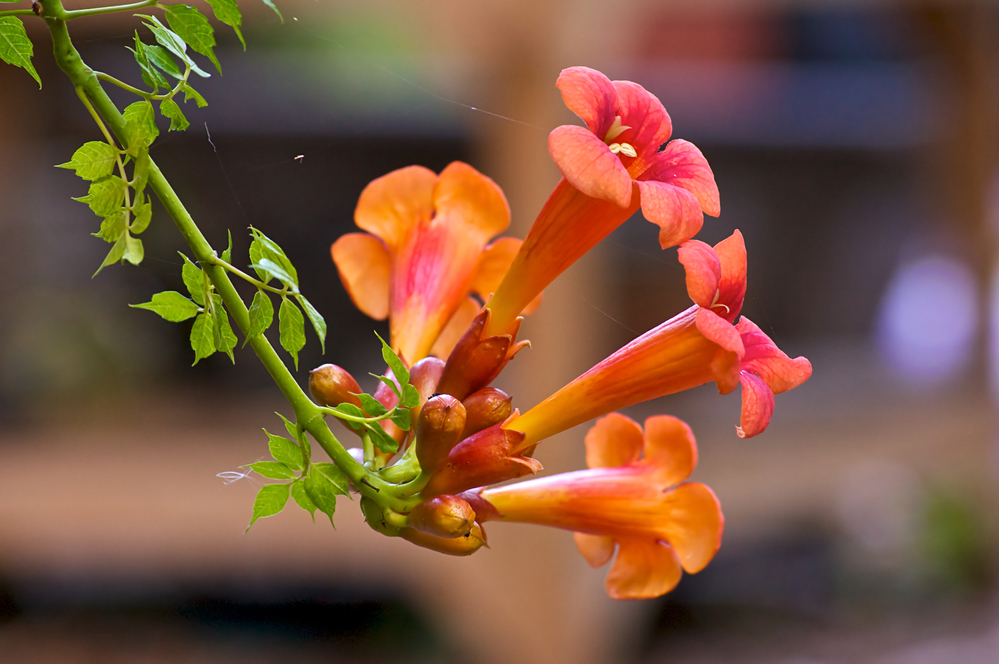
For hummingbirds, finding a mature trumpet vine is like finding the best restaurant in town. This plant can grow up to 30 feet tall and can swallow up a fence in a single growing season through aerial roots that thicken into twisted, woody vines. Clusters of tubular orange-coral red flowers with brushstrokes of yellow bloom from late May until August. Since the trumpet vine can produce hundreds of flowers, it can support multiple hummingbirds, who are extremely territorial and will chase rivals away from a food source if they don’t think it’s sufficient enough to share.
The downside is that trumpet vine, which is also known as trumpet creeper, can be invasive, and if left unchecked can damage structures and trees or anything else in its path. A gardener who wants to grow this plant to attract hummingbirds needs to plan well, training the vine on an arbor or latticework and cutting it back regularly so that it stays contained.
- USDA Zones 4-9
- Full sun to part shade
- Well-drained soil
- Blooms all summer
Trumpet Honeysuckle
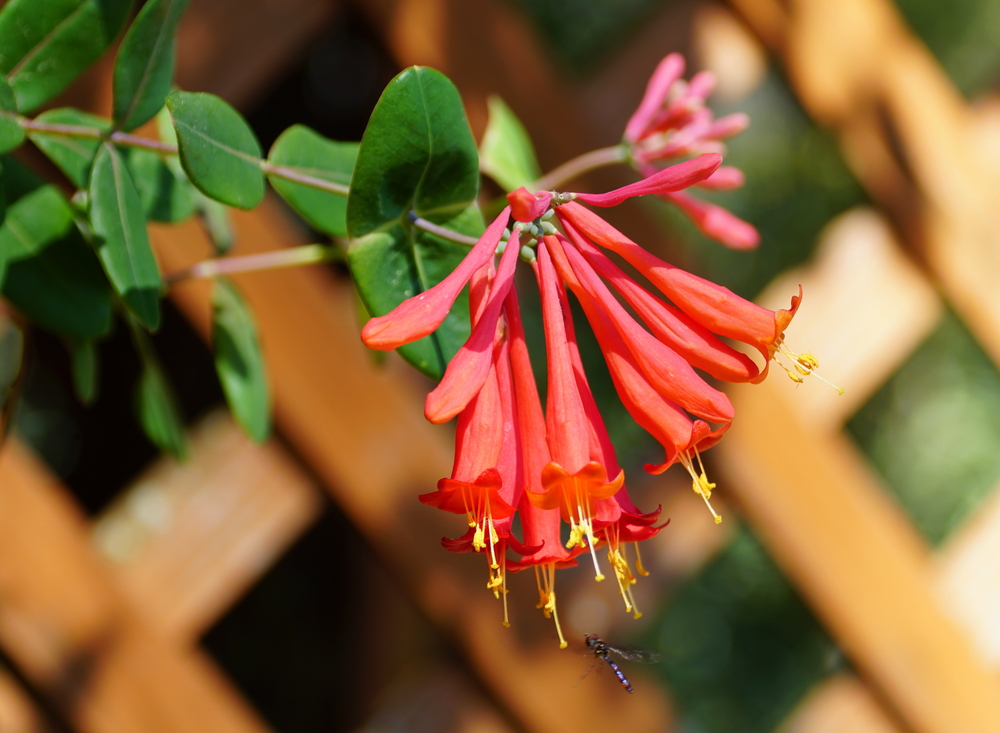
Trumpet honeysuckle is a good alternative for gardeners who are intimidated by the invasive potential of trumpet vines. This vine grows more slowly, topping out at about 20 feet from its roots. Similar to trumpet vine, it’s packed with showy flowers that can attract multiple hummingbirds, but the red and yellow bicolor blooms of the trumpet honeysuckle will usually be finished by July. It should also be trained on an arbor or some other vertical structure, but it can also grow as a ground cover.
- USDA Zones 4-9
- Full sun to part shade
- Moist, well-drained acidic soil
- Blooms from late spring to summer
Monarda Jacob Cline (Bee Balm)

Of all the perennials that can be used for bringing hummingbirds to you yard, the Jacob Cline variety of the sturdy and fragrant bee balm plant is one of the most effective and attractive. There are many varieties of bee balm, which is known for its medicinal properties, used in tea to treat everything from colds to stomach cramps and as a topical relief for cuts, scrapes and burns.
The native cultivar of the plant is the lavender-colored wild bergamot that can be found in wetlands all over North America. Hummingbirds are certainly attracted to those natives, but they absolutely can’t resist the deep red, nectar-rich Jacob Cline blooms, which grow on plants 4-5 feet high and spread quickly, especially in hot climates.
If you grow Jacob Cline bee balm, make sure you give it plenty of space. Plus, to avoid powdery mildew, trim the mature plants back to give them sufficient air circulation. You can also get a second bloom of Jacob Cline if you deadhead spent flowers.
- USDA Zones 3-8
- Full sun
- Moist, well-drained soil; drought tolerant
- Blooms from mid to late summer
Native Columbine
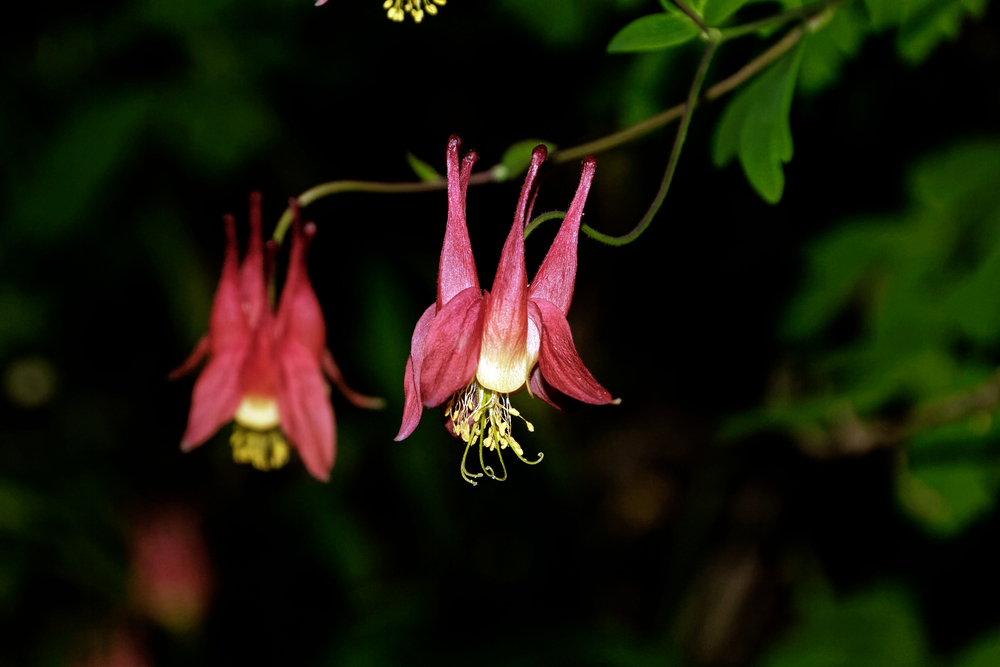
While columbine comes in many colors and varieties, the native columbine (Aquilegia canadensis) is the one that best attracts hummingbirds. The plant itself is round and compact, about a foot and a half tall and wide, with drooping, pendulous, bi-colored red and yellow flowers. Columbine blooms earlier than most other red perennials, usually by the end of May, so it can entice hummingbirds on their migratory routes.
Native columbine is found naturally as an understory plant in shady wet woodlands, and will wilt more quickly in direct sun. It is also self-seeding, meaning that next year’s plants will grow from the seeds that this year’s blooms produce, as opposed to perennials that expand through their existing root system. Once you’ve established it as a hummingbird option in your garden, you’ll find more new plants growing in different spots every spring.
- USDA Zones 3-8
- Part sun to shade
- Moist, well-drained soil
- Blooms from mid-spring to early summer
Scarlet Sage (Red Salvia)
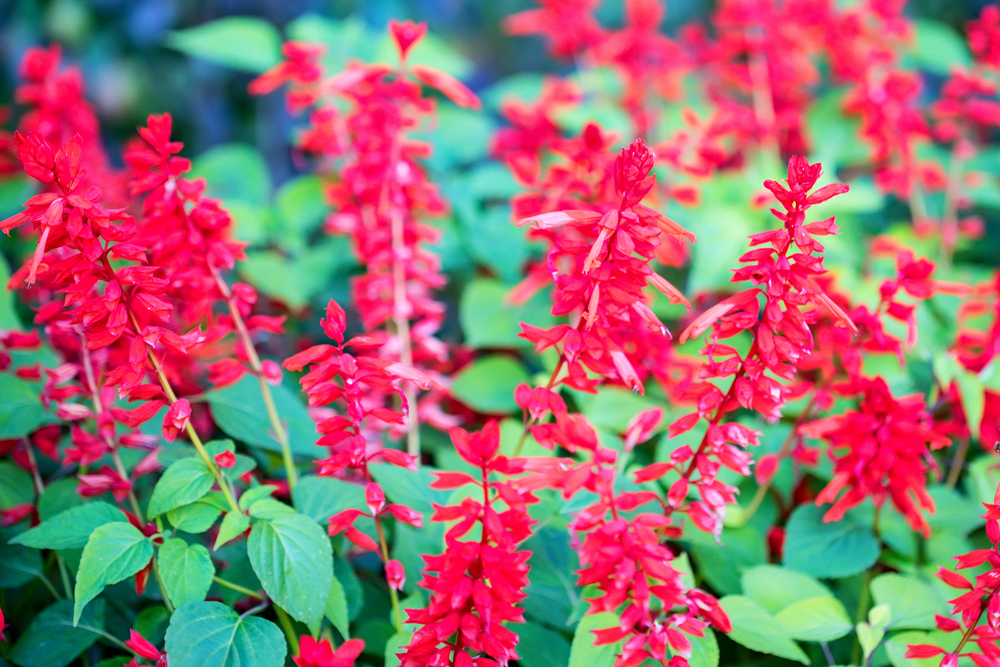
Red salvia is as red as it gets. It grows about three feet tall and two and half feet wide, with tall flower spikes. Sometimes known as blood sage or Texas sage, if you live in the south, it can be established as a perennial, and will spread over several seasons if given the room, a big red target for your local hummingbirds.
If you live north of the red salvia’s hardiness zones, you can still find flats available at garden centers, and the plants will thrive all summer. If you grow them in containers, you can bring them inside over the winter, where given enough water and exposure to light, they’ll be ready for next year’s hummers.
- Perennial in USDA Zones 9-10
- Full Sun
- Well-drained, slightly acidic soil
- Blooms from late spring into summer
Cardinal Flower
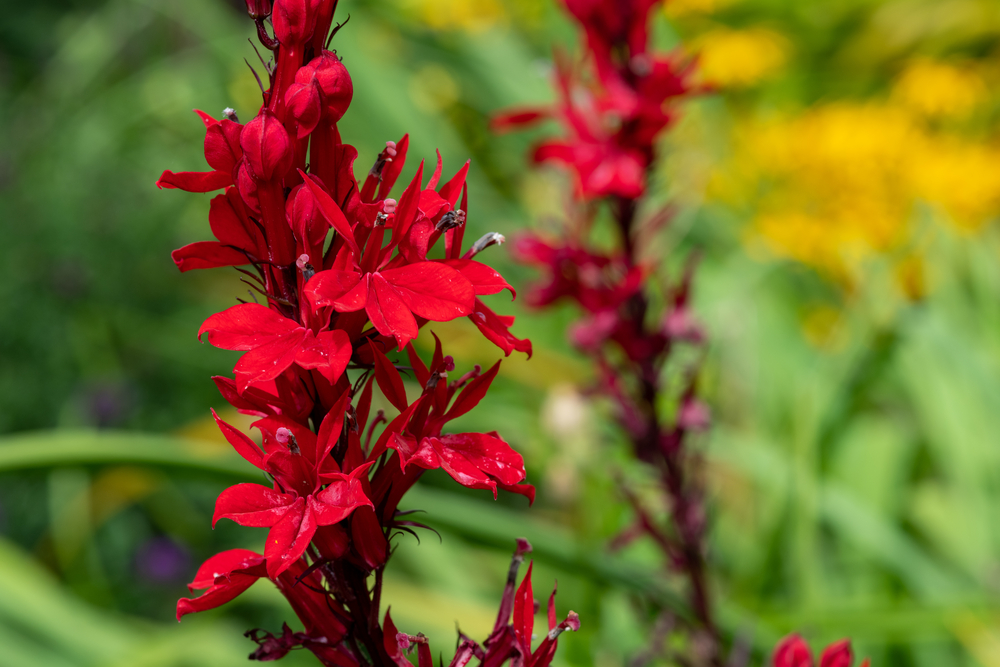
Lobelia Cardinalis is a big favorite of hummingbirds, and the bird and the plant have formed a symbiotic relationship. Since the long, thin tubular flowers of this native perennial make it difficult for insects to get to its nectar, it relies on hummingbirds to feed from it and subsequently pollinate it as they move from plant to plant.
Like native columbine, cardinal flower is a denizen of wet woods by nature, and it will bloom longer if not in direct sunlight. The blooms last slightly longer than those of the columbine, extending from early August into late September. So the same hummingbirds that visited your columbine on their way north in the spring might stop by for a drink from your cardinal flowers on their way south in the fall.
- USDA Zones 2-9
- Part shade
- Tolerates wet soil
- Blooms from mid-summer to early fall
Phlox
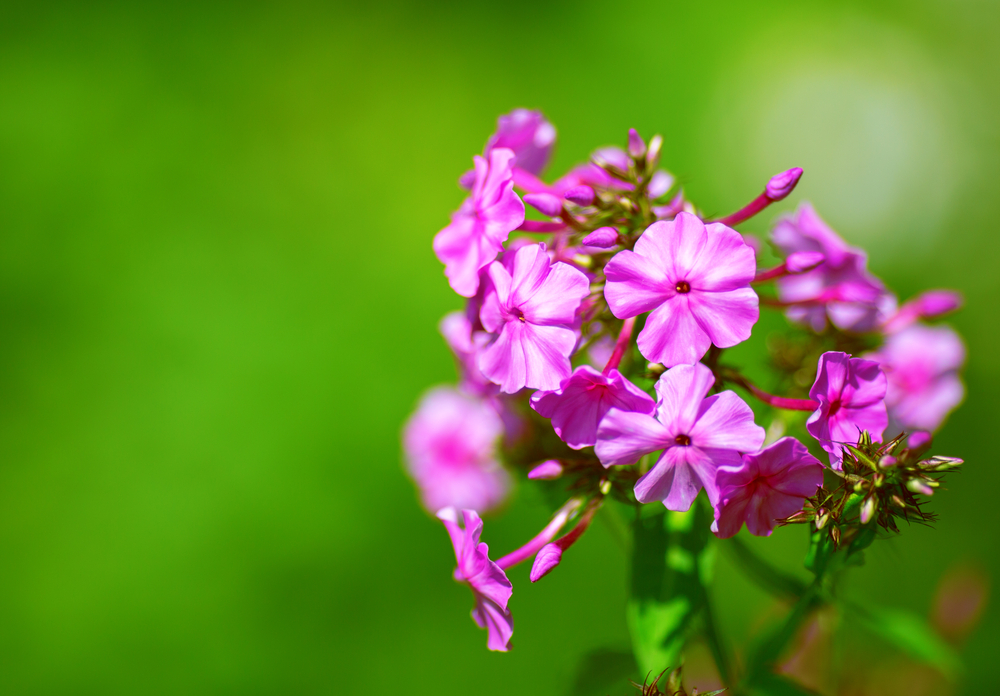
Phlox is a staple of summer perennial gardens. There are hundreds of varieties, some of which are low ground covers. The best for attracting hummers are the taller upright varieties, usually known as tall phlox or garden phlox. Of these, there are several red cultivars, most notably Starfire, Red Riding Hood and Coral Flame.
While phlox flowers are flat and not tubular, they grow in tight clusters on bushy plants. Like bee balm, the plants spread through roots to expand their territory. This helps hummingbirds in two ways: They are attracted to the nectar in the long-blooming summer blooms, and the dense foliage of the plants themselves can be a source of insects that hummingbirds rely on for protein.
- USDA Zones 4-8
- Full sun
- Tolerates all soil types
- Blooms from mid-summer to early fall
Delphinium
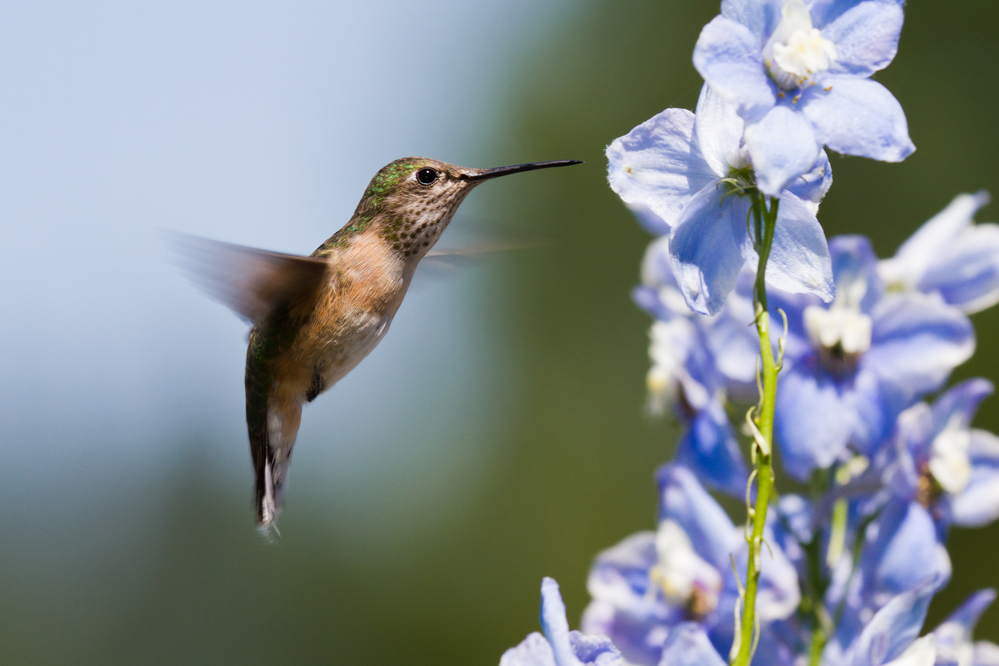
Native delphinium is a spiky blue flower that grows naturally in both shady woodlands and open prairie (hence the common name “prairie flower”). The garden varieties come in several shades of blue, purple and white and a few red shades. They’ll need plenty water if planted in full sun.
Delphinium’s contribution to your hummingbird garden is its size and the timing of its blooms. The plant grows long, bushy spikes reaching six feet or higher, containing hundreds of small bell-shaped flowers, which are among the first to bloom in late spring. If you cut delphinium back after the first bloom, the plants will produce a second bloom in late summer. The timing could not be better for migrating hummers, who will find plenty of nectar in the tall, showy flowers.
Delphinium flowers will topple over easily in wind and rain, so make sure you stake them so your hummingbirds can find them easily.
- USDA Zones 3-8
- Full Sun
- Well-drained soil
- Blooms in early summer
- Second bloom in late summer if cut back
Canada Lily
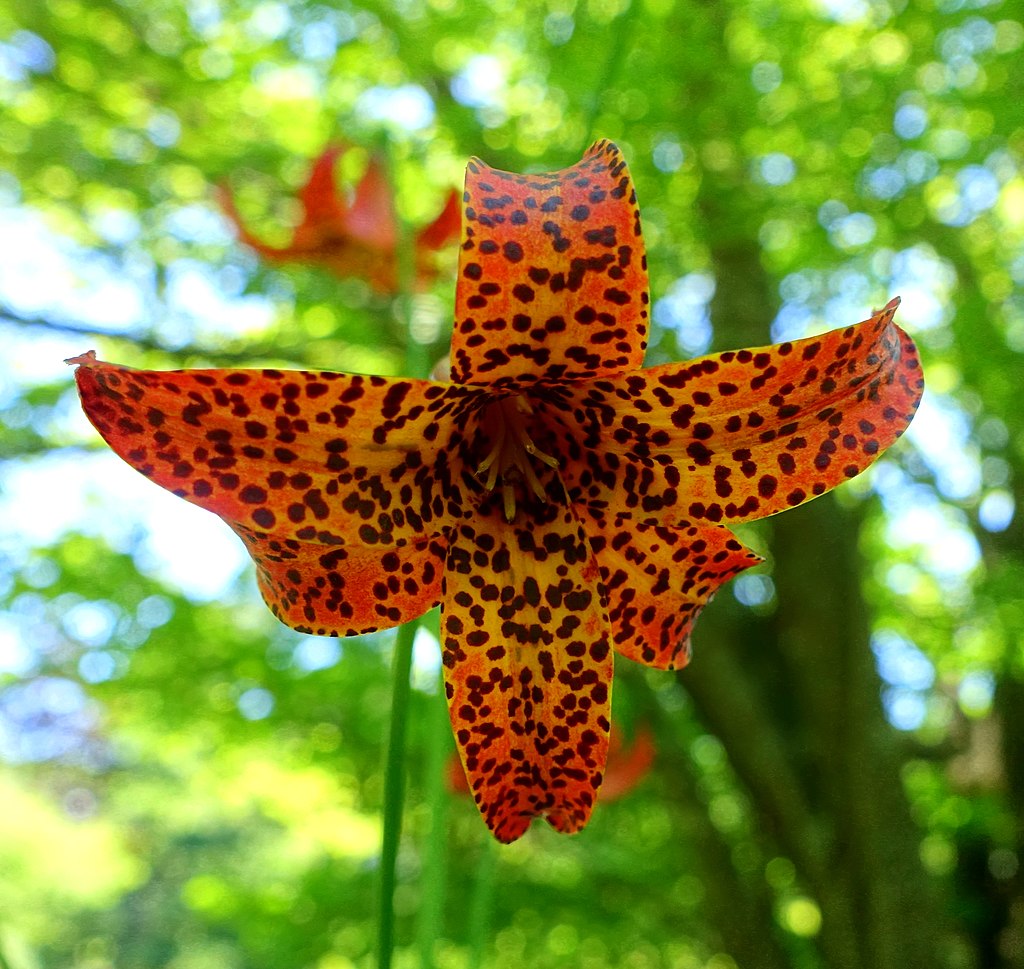
Of the perennials on our list, the Canada lily is the only one that is grown from a bulb, and the best time to plant any bulbs is in the fall. But given the right conditions, especially loose soil in which to spread its anchor roots from the bulb, this plant will mature and bloom through June and July if planted in early spring. Canada lilies are gorgeous specimens that can grow up to 8 feet tall and produce 20 blooms of yellow to red flowers on a single stalk.
Like many hummingbird favorites, the deep tubular shape and pendulous habit of lily flowers ensure that the birds can use their sword-like beaks to reach the nectar that bees and other insects might not be able to reach. Unlike many garden lilies, The Canada lily has no scent, another evolutionary trick that flowers use to attract hummingbirds, which unlike bees and other insects, don’t use scent at all as criteria for choosing which flowers to visit.
- USDA Zones 3-9
- Full sun to part shade
- Well-drained soil, moist but not too wet
- Blooms in summer
Lupine
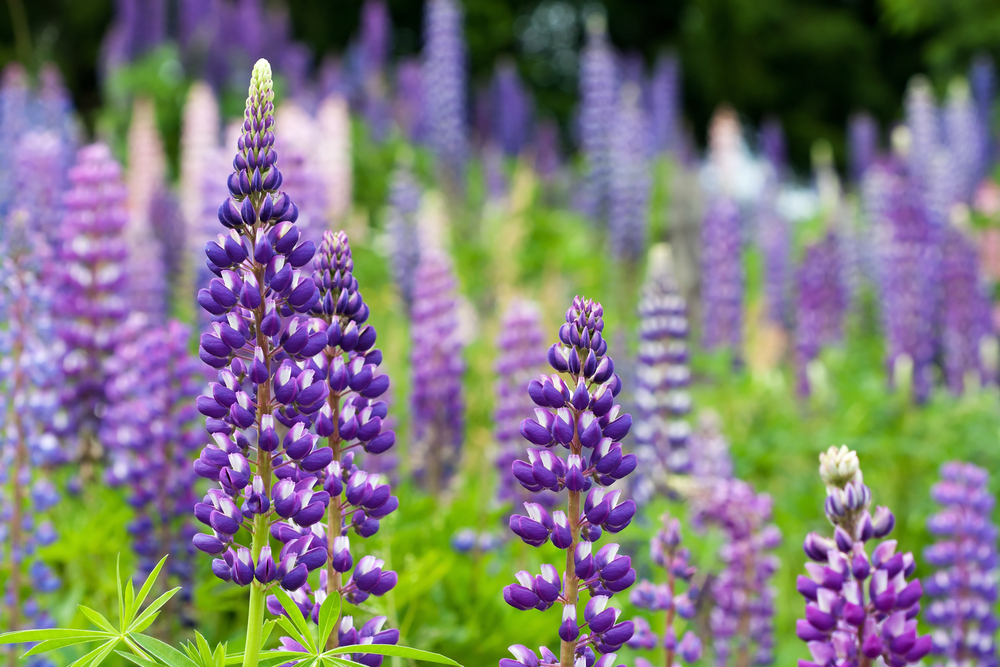
Like delphinium, lupine’s main attraction to hummingbirds is in the way it stands out from the crowd and packs a feast of flowers on a single stalk. Also like delphinium, the parent native plant is blue, but being a true sun lover, is most often found naturally in open meadows. Lupine is one of the earlier “cottage perennials”, sending up showy 3-4 -foot stalks of flowers in late May, around the same time as columbine.
After blooming, lupines will produce seedpods, which can mature into new plants quickly. Like columbine, a single lupine plant will parent many new plants next year if you let it go through its life cycle, and the hummingbirds will come back to find the flowers.
- USDA Zones 4-8
- Full Sun
- Well-drained, acidic soil
- Blooms from late spring to mid-summer
Annual Flowers that Attract Hummingbirds
If a traditional garden is not an option, you can still invite hummingbirds to your outdoor space with container plants, window boxes and hanging baskets. Annuals in ready-to-plant flats will give you the fastest color, but some of the annuals that we’ve included on this list can also mature from seed quickly enough to provide your flying friends with summer and fall nectar.
Petunia
While the smaller and more densely packed multiflora petunias are great for dressing up the front of a garden bed, the larger flowers of the grandiflora and the trailing petunia varieties are more suited to containers. While they look great in window boxes, this can be dangerous for hummingbirds, who are prone to window collisions. So if possible, the railing of a deck or porch would be a better spot to place a window box.
Calibrachoa
Though recognized as a separate species from petunias, calibrachoa is sometimes called “trailing petunia.” It differs from petunias both in the variety of colors on one plant and in its long, maintenance-free growing season. While petunias have to be cut back in summer heat to produce more blooms, the “million bells” variety of calibrachoa drops its spent blooms and regenerates on its own, making it a great choice for hanging baskets that can put you at eye level with hummingbirds.
Nasturtium
The blooms of the nasturtium are another tubular-shaped flower that favors hummingbirds over insects. They can be bought in containers but are also grow well from seeds directly sown into your garden. They are beneficial for drawing aphids away from tea roses and other ornamentals and the flowers will keep blooming for the hummers right up until the first hard frost.
Cleome
Cleome might not be the first nursery flower that catches your eye at the garden center in springtime. The immature plants look like little ferns, but they mature into 3-4 feet high beauties. Known as spider plants, they grow easily from seed if given full sun, and their heads of spiky, nectar-packed flowers are a hummingbird favorite.
Lantana
Lantana is one of the most attractive of container annuals, with multicolor clusters of flowers that withstand heat and bloom until frost. There are several varieties that feature a combination of orange and deep red, as well as trailing varieties. Lantana grows quickly, mounding into a mini shrub where your hummingbirds might also find some insects on which to feed.
Zinnia
Among the easiest of flowers to grow from seed, Zinnia is available in a wide variety of colors and sizes, and plants will mature in as little as 60 days. If you’re planting them for hummingbirds, you may as well go big. Seeds of Benary’s Giant Zinnias are available in deep red as well as other bold colors, with blooms that grow 3-4 inches across and keep on coming all summer into the fall on 40-inch-tall plants.
Impatiens
Impatiens are easy as flowers get when it comes to maintenance, which is why they are among the most common of annuals planted in garden beds. While the flowers are not as deep as some of the hummingbird’s other favorites, the bold colors of the impatiens’ long-lasting blooms will certainly catch its eye. New Guinea impatiens have a mounding habit that works well in hanging baskets. While they prefer semi-shaded areas, they will do well in full sun if kept watered.
Fuchsia
The popular magellanica variety of fuchsia is called “hummingbird fuchsia”, and with good reason. The flowers have the deep red color and tubular shape that the birds love, and if kept in a shady spot (and away from windows) it’s the perfect plant to entice hummers to spend some quality time at your hanging baskets.
Tithonia (Mexican Sunflower)
You’ll be amazed at how quickly and how large tithonia will grow from seed, and how many bright orange flowers one plant will produce. Unlike most of the others on our list of annuals, you’ll want to find space in the ground for the Mexican sunflower, which can grow over six feet high, producing a fiesta of 3-inch-wide daisy-like flowers that are a magnet for hummingbirds, butterflies and bees.
Mandevilla
The only vine on our annuals list, mandevilla is a good choice for a large container with a trellis on your patio or deck for a potential up-close hummingbird encounter. There are many color varieties, including several shades of red, all of them with deep flowers that your hummers will recognize from their tropical winter habitat. Mandevilla needs some shade to keep from burning, and it can be over-wintered indoors if you don’t have pets.
While about 10% of the 300 species of hummingbirds in the world are endangered, populations of hummingbirds that breed in North America have remained stable. But everybody needs a little help from their friends. Growing flowers to attract these wonderful creatures will enrich your life and make sure that they’re still around to amaze and enchant future generations.
